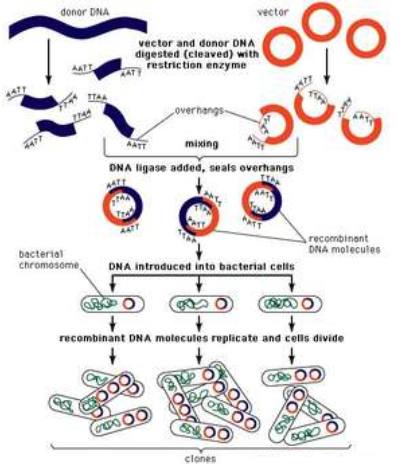Genetic engineering has been categorized as an area of molecular biology that involves Changing the structure of genetic material which is also referred to as deoxyribonucleic acid or DNA. Recombinant DNA, also referred to as rDNA, is a strand of DNA which has been manipulated by scientists. Genetic engineering and rDNA move hand in hand; genetic engineering would be nothing without the use of rDNA.
DNA in Genetic Engineering is a double-stranded molecule which contains genes, non-coding regions, and gene regulatory regions. Genes are hereditary parts which encode proteins and define the features of organisms. It also make individual different from other living organisms and other people; genes and DNA make a person unique. Scientists use DNA to make rDNA in the laboratory. Scientists can not generate DNA so they make use of natural DNA from different organisms to make rDNA. Recombinant DNA technology gives scientists to unite DNA from two sources: human DNA with bacterial DNA to produce the resulting proteins in cell cultures.

Recombinant DNA can be defined as a DNA molecule which is formed by joining DNA fragments from different sources. Recombinant DNA is derived by cutting DNA with enzymes, called restriction enzymes, which can cut DNA at a particular sequence. The cut DNA may be joined together with another DNA, cut with the same enzyme, using another enzyme, called DNA ligase. Most, the rDNA is cloned into a plasmid and transformed into an E. coli cell. E. coli will many the plasmid and the rDNA in it or produce the protein encoded by the rDNA.
Research makes it clear that the first rDNA molecules were generated in 1973 by a Paul Berg, Herbert Boyer, Annie Chang and Stanley Cohen of Stanford University in conjunction with the University of California San Francisco. This is seen as the birth of genetic engineering. Recombinant DNA is the most essential tool used by genetic engineers. Without recombinant DNA there wouldn’t be genetic engineering.
Looking at DNA manipulation and generation of recombinant DNA it could be discovered that it has several applications. The genes in DNA encode proteins which carry several functions in the human body. With the help of rDNA, scientists can produce proteins in the laboratory. For instance, vaccines, human insulin, and human growth hormones are derived from recombinant DNA technology in the laboratory. Before the “arrival” of genetic engineering, insulin helped to treat diabetes was isolated from pigs and cows.